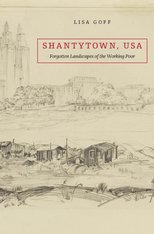Difference between revisions of "Shantytown, USA: Interview with Lisa Goff"
(Created page with "__NOTOC__ {{Mediawiki:kindleoasis}} {{Book Infobox |name = '''''[http://www.amazon.com/gp/product/0674660455/ref=as_li_tl?ie=UTF8&camp=1789&creative=9325&creativeASIN=06746604...") |
(No difference)
|
Revision as of 06:57, 31 May 2016
The Harvard University Press recently published Lisa Goff's new book Shantytown, USA: Forgotten Landscapes of the Working Poor. There's a chance that one of your American ancestors lived in an American shantytown. While we may not realize it now, shantytowns were a common feature of 19th century America. Goff's book explores not only how shantytowns became a prominent feature of America's towns and cities, but why middle class Americans eventually turned on them and their residents.
Lisa Goff is currently an Assistant Professor at the University of Virginia in the English Department and American Studies Program. She is also the director of the Institute for Public History. Before becoming a professor, Goff had a distinguished career as a business journalist. She was the Managing Editor for Crain's New York Business and wrote for numerous publications including Preservation, Progressive Architecture, Reader's Digest, Working Women and Good Housekeeping.
Here is our interview with Professor Goff.
Why did you start researching shantytowns? What drew you to this topic?
Working class history, even the very best of it, largely ignores working-class landscapes. Studying shantytowns was my way of adding the evidence of the landscape to the historiography of labor, urban history, and material culture. Shantytowns are especially intriguing because they were built by the working poor, a class of people who have gotten relatively little attention from scholars. I initially thought this would be a 20th century book, focused largely on the shantytowns known as Hoovervilles built during the 1930s. But as I kept researching, I had to keep pushing the start date back further and further into the 19th century. I stopped at 1840 but could have gone back at least to 1820 if not further.
Is there a good definition for shantytown? Is a shantytown defined more by the structures in the space or by the way people live in these spaces?
You’ve hit on two important aspects of the definition: that shanties are not defined solely by materials or building techniques, and that they have a performative dimension. Shantytowns exist quite literally off the grid, and as such they express a working-poor ideology of dwelling that, I argue, elevates values of occupation, adaptation, and reinvention over middle-class imperatives of property, uniformity, and legibility. I call this “oppositional planning” in the book, which I think captures the fact that shantytowns have their own internal logic and are not merely haphazard groupings of shacks.
But I do have a working definition for shantytowns: communities of single-family dwellings built by poor working people for themselves from materials at hand. They vary considerably, from mud huts and teepee-like “pole shanties” to log and wood structures, often but not always built by immigrants or African Americans.
They are often located in low, swampy, or otherwise undesirable areas near owners’ workplaces, and in the 19th century you often see them forming along the paths of growth and development—along railroad lines or canals, adjacent to factories, in the interstices of booming cities. In the 20th century, the definition shifts a bit: shantytowns are built by people who have been thrown out of work, made homeless and jobless by the crashing economy.
Another thing they have in common is that they infuriate the middle class.
I would imagine that researching shantytowns was extremely difficult and you even describe them as “forgotten spaces". These spaces would appear to be unregulated, unmanaged and extremely flexible. What type of sources did use the learn about these spaces?
Indeed, there was never a listing for “shantytown” in any index I ever consulted, and the research for the book involved piecing together many different texts and artifacts. Newspapers were a key resource, but I also found shantytowns in fiction, art, and popular culture. Sometimes they were hiding in plain sight. Henry David Thoreau built his famous cabin at Walden from the skeleton of a shanty he purchased from an Irish railroad worker, and James Fenimore Cooper housed one of his frontier heroes in a shanty. Shanties and shantytowns appear in the writings of Ralph Waldo Emerson, Emily Dickinson, Louisa May Alcott, and Herman Melville. They turn up in Civil War photographs, minstrel shows, and American Impressionist paintings.
In the inventory for the 1893 World’s Columbian Exposition I found a painting called A Shanty Town in New York, depicting a warren of sloped-roof shacks inhabited by huddled, rag-wrapped figures pushing carts. At the historical society in Washington, D.C., I discovered a series of etchings by an artist obsessed with shantytowns in the District in the 1880s, who documented shantytowns persisting among the towering new mansions being built in the growing federal city. In the archives at the Smithsonian, I found sheet music for country songs about shantytowns in the 1930s and 1940s, and then an entire musical comedy from 1882—a minstrel-inspired farce called Squatter Sovereignty that charted the rise and fall (literally, in an onstage explosion at the end of Act III) of a real Manhattan shantytown on upper Fifth Avenue. Shantytowns were everywhere in American culture, but had never been the focus of a scholarly book.
What did you learn during your research that surprised you the most?
Squatting wasn’t the norm in the 19th century—many if not most shantytown dwellers paid ground rent for the land where their shanties sat. There are numerous accounts of shanty dwellers going to court to fight eviction, and winning because they had legitimate claims to the property.
Another surprises: shantytowns were not always the temporary settlements that the middle class portrayed them to be. I found shantytowns in Brooklyn, Manhattan, Atlanta, and Washington, D.C., that persisted for many decades. There are accounts of two or even three generations occupying some shantytowns.
I’m assuming that these perceptions of shantytowns differed between middle-class residents and the people who lived in shantytowns. How have the perceptions of shantytowns changed over time in the United States or have they been fairly consistent?
The middle class has consistently depicted shantytowns as slothful, depraved “dens of vice and wretchedness,” breeding-grounds for crime and violence that are frequently depicted as being “foreign” or uncivilized, even bestial. There are bursts of nostalgia in the 1880s (an article in Scribner’s praised their “disreputable freedom”) and again in the 1930s, but in general the middle class denigrates shantytowns and shanty dwellers in ways that challenge their American-ness.
It’s harder to get at what shantytown residents thought of themselves, but popular songs and theatrical entertainments consumed by poor and working-class people suggest that they embraced portrayals of shantytowns as sites of hospitality, frugality, family, self-employment, and resourcefulness. But like middle-class urbanites, working–class people used shanties rhetorically to make distinctions among themselves, often associated with immigrant status or ethnic backgrounds.
In the 19th century, cities began to make serious efforts to control or regulate shantytowns. Were these efforts more of attempt to change the space itself or the behavior of the people who lived in these spaces?
I think the zeal to control and reconfigure urban space was often fueled by a desire to get rid of poor people, to literally exile them from the urban core altogether. One of the moments that really cemented my interest in this topic was when I came across the minutes from an 1830s meeting of the Manhattan Board of Assistant Aldermen, in which the members were publicly wringing their hands over the consequences of their decision to demolish blocks and blocks of shanties located downtown. “Where are the poor to go?” they lamented. But they washed their hands of the consequences. In a sense, shantytown demolitions in the late 19th century were a warm-up for the urban renewal projects that displaced so many poor Americans in the 20th century.
How did these regulations ultimately effect the residents of these neighborhoods?
First, legislation regulating the possession of farm animals within the city limits disrupts two major shantytown livelihoods, dairies and market gardens. Catherine McNeur detailed this phenomenon in her lively history, Taming Manhattan. (Here is a link to our interview with Catherine McNeur) Next, consolidation of municipal powers of “ejectment,” as eviction was known then, and the tightening of zoning and building codes toward the end of the 19th century made it easier to demolish shantytowns. Starting in the 1920s, public housing schemes provided ostensibly better housing for the poor. Shantytowns never completely disappear, but they diminish in number and size at the end of the 19th century and, after surging during the Depression, largely fade from view in the wake of New Deal policies.
How would you recommend using your book in a class?
Use it to animate and complicate standard topics like industrialization, urbanization, and the construction of class in America. Use it to challenge conventional thinking on historical figures and events. A chapter on Walden, for example, shows Thoreau in a whole new light, and the evidence of shantytowns forces a reconsideration of the grid. Use it to add a new dimension to the history of African Americans during Reconstruction and into the 20th century. Use it to populate the landscapes of American cities with more than middle- and upper-class actors. Use it to teach students how to read visual art, popular music , plays, material culture—everything from quilts to Morning Glory stoves—and landscapes themselves to analyze class and race in the U.S.
Undergraduates will appreciate the narrative drive of the book, and graduate students will find the in-depth treatment of place, space, and material culture engaging. While especially appropriate for inter-disciplinary classes like American Studies, Shantytown USA will also serve students of American history, American literature, material culture, urban history, vernacular landscapes, urban planning, media studies, and the visual arts.


